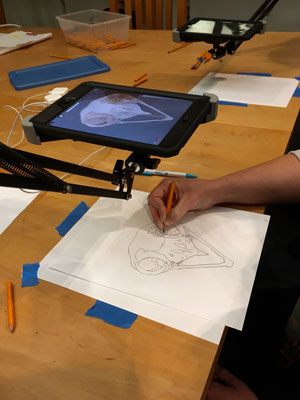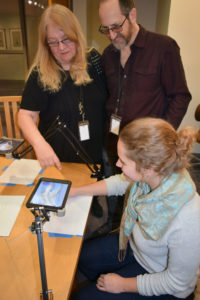By Donald H. Harrison


SAN DIEGO – Jonas Salk, the discoverer of the polio vaccine, was fond of paraphrasing the mathematician Jacob Bronowski on the possible beneficial results from an interrelationship between the sciences and the arts. Bronowski, who became known to millions of Americans through the PBS television series The Ascent of Man, suggested that perhaps Copernicus conceived the idea that planets circle the sun, instead of vice versa, after viewing Leonardo da Vinci’s drawing “The Vitruvian Man,” in which the body of a man is shown with four legs and four outstretched arms. Perhaps Copernicus imagined the man in that drawing spinning in place, causing his hands to circle him in orbits.
Salk believed that because artists and scientists have different ways of viewing the world, their talents may complement each other, leading both to new art forms and to new scientific discoveries.
Artists Larry and Debby Kline have been involved in a pair of collaborations with scientists, including a current engagement as artists in residence at San Diego’s Natural History Museum in Balboa Park, where they are updating the work of 19th-century ornithologist John James Audubon’s “Birds of America” portfolio. They are choosing birds known to be extinct, or in imminent danger of being declared extinct, and are redrawing them with backgrounds suggesting what caused their demise. For example, one of the drawings is of an esquimaux curlew, which probably suffered extinction as a result of loss of habitat. In the background of the drawing is a picture of a man plowing a field.
Another extinct bird the artists are drawing—later to be inked in and painted—is the pinnated grouse, which hunters used to shoot for sport, rather than for eating, often leaving piles of them dead on the ground, according to the Klines.
The couple will make a set of 10-12 drawings measuring 30 by 42 inches, which was the size that Audubon chose so that his bird drawings could be life size. The Klines will donate one of their drawings to the Natural History Museum’s collection. They anticipate that the set will be reproduced in smaller-version prints to be sold to bird lovers and collectors.
In drawing the birds, the Klines are utilizing a camera lucida, which is a device that allows an artist to view the bird through a lens while drawing it on paper placed nearby. Although the device, in primitive form, has been around for centuries, today the process is made much easier with an iPad, which enables an artist to see his or her hand as it traces the outline of a photograph.

As part of their residency at the Natural History Museum, the Klines have photographed skulls of various animals, which can be viewed with the iPad’s camera lucida application and traced by museum visitors. This activity is particularly popular with young visitors who are familiar with iPads, but members of older generations also have been persuaded to try the technique, even those who thought they couldn’t draw. The adults have been amazed how easy it is to execute a drawing, according to the Klines.
Sometimes students who might otherwise be restless in a museum sit down to do the drawings, and spend a half hour or more tracing the lines of a skull. Afterwards, they typically go downstairs to the gallery where the skulls are on exhibit and find the ones they have drawn. In that way, suggest the Klines, they become more involved with the subjects than they might have otherwise. “They have a sense of ownership,” comments Debby.
In a collaboration with neuroscientist Saket Navlakha of the Salk Institute for Biological Studies, who is interested in how organisms make decisions to go from one space to another, the Klines rigged a piece of conceptual art at the San Diego Art Institute, also located in Balboa Park. From a comfortable sitting area, a network of wires ran up to the ceiling and then down to various pieces of art, where sensors could compile data on how many people visited that art piece, and for how long. An electronic tally board indicated which art pieces identified by letters of the alphabet were receiving the most attention. Visitors did not know which letter had been assigned to which art piece, and when they would see a letter on a screen registering more attention, they would look around the gallery to see if they could determine which art piece the letter represented. Often visitors would return to the comfortable couch with its tally board. It was, perhaps, no surprise that the piece which registered the most attention from visitors was the experiment itself.
Navlakha told the Klines of an experiment by Toshiyuki Nakagaki of Hokkaido University that used slime molds and a large map of Tokyo. Food was placed at various centers of population on the map, and as the slime molds made their way from one source of food to another, they, in essence, replicated the transit map of Tokyo. What may have taken engineers years to conceptualize, the slime molds were able to do by instinct, simply by moving back and forth between food sources.
Asked what lasting value such art projects may have, the Klines suggested that they may be models for how museums interact with visitors in the future. By the time people park their cars at Balboa Park, and walk to a museum, then start walking through the museum to look at exhibits, they can become very tired, even exhausted, the Klines suggested. Creating exhibits at which visitors can sit down and become involved for an extended period of time may result in greater appreciation for the subject, and for the museum’s mission.
*
Harrison is editor of San Diego Jewish World. He may be contacted via donald.harrison@sdjewishworld.com